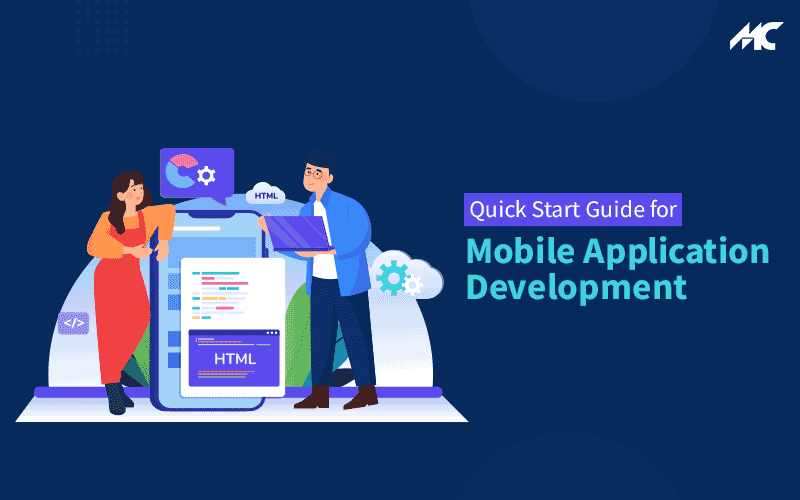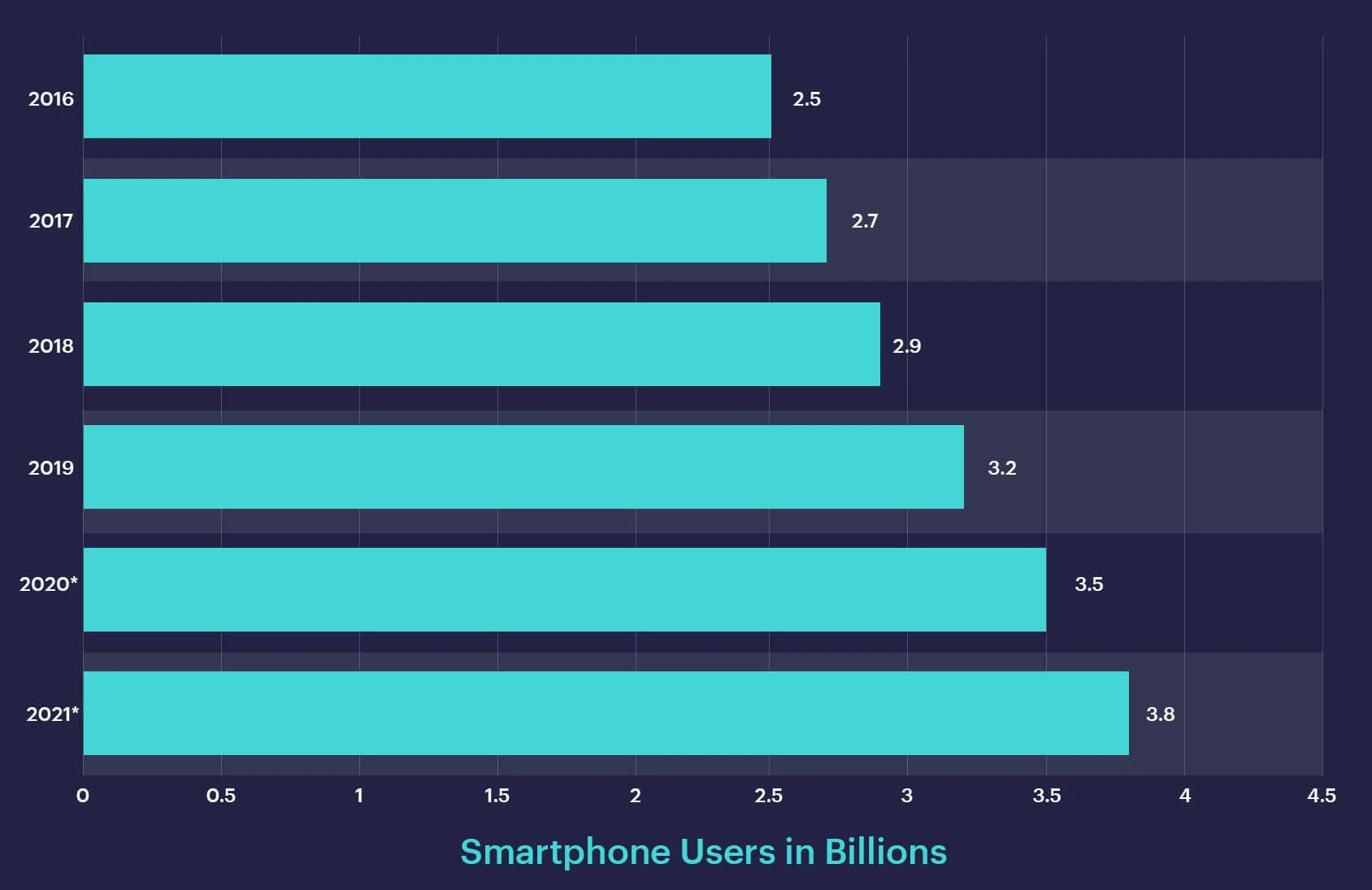Quick Start Guide for Mobile Application Development
Today, smartphones have made it easier for businesses with their customers. The rise of the smartphone market with iOS and Android operating systems has made mobile apps a very effective way of promoting a business. The mobile apps make it a lot easier to avail of any service from just the fingertips of the users. Mobile app devices make it very easy to access information anytime and anywhere. The Mobile Application Development guide is a complex process and requires a high level of technical expertise.
- What Is Mobile Application Development?
- Unprecedented Growth of Mobile Users
- Why Should You Outsource Your Mobile Application Development
- Reasons for the Market Growth of Mobile Applications
- Why Should You Develop a Mobile Application for Your Business?
- Different Approaches for Mobile Application Development
- The Leading Platforms for Mobile Application Development
- The Mobile App Development Process
- Everything About App Development
- Team Required for Mobile Application Development
- Cost of Mobile Application Development
- Collaborating with a Mobile Application Development Company
What Is Mobile Application Development?
Mobile application development is the process of creating applications that are meant for mobile devices. These mobile applications can be downloaded by the users from the app stores like the Google Play Store and App Store.
Mobile app development is the process of creating software that can be installed on various devices. This process also provides access to various APIs.
The IT world is adopting mobile application development to help the increasing number of smartphone users. Freelancers, professionals, and mobile application development companies are providing mobile apps for both iOS and Android mobile platforms.
In this mobile application development guide, we are going to give a complete overview and guide on developing mobile applications.
Unprecedented Growth of Mobile Users
Mobile internet users had already overtaken desktop internet users. Even during the pandemic era, the sale of smartphones and smart devices has continued to grow. Mobile users have become the top priority of every business that wants to create a loyal customer base.
Market experts are already predicting that the mobile app market will touch 1 trillion USD for app revenue by 2023.
Why Should You Outsource Your Mobile Application Development
When it becomes to developing your mobile application, you have three options to choose from;
- Either you can develop the app on your own
- Hire freelancers to develop the app
- Collaborate with a mobile app development company
Developing your mobile is a long and tedious process especially if you don’t have any prior experience.
Today, more than 47% of businesses are outsourcing their development to professional mobile app development companies. This could drastically reduce their cost, and ensure great quality, and timely delivery. They are developing a mobile app for both iOS and Android mobile platforms
Reasons for the Market Growth of Mobile Applications
Let’s understand the reasons for market growth in our mobile application development guide
1. The Fall in Data Prices and Rise in Internet Accessibility
People in developing countries like India, China, Brazil and more have gained access to smartphones and the internet recently. In the last decade, we also saw the emergence of the internet as the primary medium of communication.
It provided us with a far better and more affordable way of communication as compared to traditional ways. Above all, the e-commerce industry also grew faster with innovations in the internet and mobile applications.
The big e-commerce giants like Amazon started to provide attractive offers and discounts on their applications. This seriously threatened the existence of traditional brick and mortar stores.
By introducing 4G telecom technologies, we were able to lower down prices of data plans. Ultimately, this led to the growth of active internet users in both the rural and urban parts of every country.
2. Just For the Sake of Being First
Every big business wants to overtake the competition and be the first player in the market. This made leading companies develop their own applications and start mobile application development. In fact, they often hire a mobile app development company to ensure their mobile works perfectly.
3. The Emergence of Machine Learning and Artificial Intelligence Technology
Artificial intelligence has become a major player in determining success in almost every industry today. It provides predictive analysis that helps businesses to improve their products, services, and processes.
Top IT companies are already using this future-ready technology to gain valuable insights from their consumer behavior to make better business decisions. Today, artificial intelligence is integrated into many mobile applications that just makes human efforts much easier. Thus, it can offer the path to unexplored market possibilities for businesses.
Why Should You Develop a Mobile Application for Your Business?
Today, businesses of almost every size are going mobile with their own mobile application. This has become a common trend to remain competitive and increase productivity in the business world. Lastly, these are some major reasons why you should consider developing your own mobile application for your business;
#. Improvement in Customer Engagement
Businesses develop their mobile app for both iOS and Android mobile platforms with custom features and experience while keeping business requirements in their mind. It creates a direct communication channel between the business and the customers.
The mobile applications enable businesses to send push notifications about important updates, offers, discounts, etc. If your customer base finds the information relevant or useful, then they are going to convert into loyal customers and get attached to your brand.
#. Improvement in Accessibility
Developing a mobile application can also improve business accessibility. Businesses can quickly notify their consumers about any recent changes, while the users can just use the app in a matter of seconds.
It removes the barrier of manually searching the business name on a web browser. The mobile-only exclusive features further improve the bond between customers and businesses.
#. Give Value to the Customers
Businesses often use mobile applications to digitalize their loyalty programs that offer additional benefits to the customers. These memberships can provide rewards to the customer through the mobile application. Thus, this leads to more downloads and more return customers.
#. Changing the Retail Experience
It takes huge expenditure to run a fully-loaded retail store in any location. Thus, mobile applications are helping retailers to get ahead in the game and reshape the retail industry to provide a streamlined online shopping experience.
The digitalization of the shopping experience cuts down a lot of operational costs and increases profitability. Ultimately, this has posed serious competition to the traditional brick and mortar stores.
#. Create Brand Awareness and Improve Marketing
Developing a mobile application is important for a business to gain credibility in the market. When an individual downloads an application, it becomes an asset to their smartphone. Thus, it creates an identity in their day to day life.
This is not the case with websites as they are forgotten quite soon. In fact, a mobile application gives you the opportunity to show your brand’s creativity and portfolio in one single place.
Mobile apps are an important asset to businesses to connect with their customers. Plus, it also creates a great marketing opportunity to constantly showcase your products or services on an independent channel.
#. Stay Ahead of the Competition
Not every business has yet developed its mobile application. However, those who have done, are able to steer ahead of the competition. By providing a mobile application for download, you create big credibility for your brand and retain your customers better. Plus, you make them realize that you innovate with the changing technology.
#. Discover Crucial Consumer Insights
The 21st-century digital world is powered by data and insights. As a result, a mobile application can help your business to gain access to consumer insights and let you learn to improve your products/services/processes. Lastly, there are smart analytics tools that help you understand the nature of;
- Daily and weekly users
- Understand demographics such as age, gender, type, device, etc
- Downloads and uninstalls
- Retention rates
Different Approaches for Mobile Application Development
There are three different types of mobile application development approaches. Each of them is ideal for individual business and scaling requirements;
1. Native Applications
Native applications are focused on providing the best experience to the user by taking advantage of the best potential of the device, app, and operating system. However, this approach takes more time and effort than the other two methods.
The developers have to work on multiple code bases for multiple platforms. Native applications provide a more refined, polished, and a platform-specific experience than ordinary applications. Furthermore, this approach to mobile application development requires expertise in technologies such as Java, Kotlin, Swift, Objective-C, and more.
2. Cross-Platform Applications
A cross-platform application is usually written in different languages and frameworks to support multiple operating systems. Even if they have a single code-base, these applications could effectively execute on multiple operating systems.
Mobile application developers take the best advantage of platform-independent technologies such as HTML and CSS to develop cross-platform mobile applications at lower development costs. However, expertise in mobile app development, JavaScript, TypeScript, C++, Flutter, Dart, and React Native is necessary for cross-platform application development.
3. Hybrid Applications
A hybrid application is platform-independent and can run on various operating systems. These applications are built by using HTML, CSS, and JavaScript. The code of the application is shared through Android, iOS, and Web applications. Thus, it becomes compatible with every platform in less time.
Developers have to use advanced tools to ensure smooth interaction between the native platform and the online experience.
Let’s Understand the Subtle Differences Between Native Apps, Cross-Platform Apps, and Hybrid Apps from This Chart.
| Native Applications | Cross-Platform Applications | Hybrid Applications | |
| Advantages |
|
|
|
| Disadvantages |
|
|
|
| Examples |
|
|
|
| Tools & Technologies |
|
|
|
The Leading Platforms for Mobile Application Development
– Android OS
There are over 3 billion Android-powered devices in the market, which makes it a dominant mobile operating system for Mobile application development.
Developing an Android application provides more customization and scaling possibilities. Moreover, it is an ideal choice if you want to avail huge customization options and the market presence of over 80%
– Apple iOS
iOS is a mobile operating system developed by Apple for its iPhone, iPads, and iPods. This platform is ideal to access the high wealth user base and expect better ROI. It is a dominating operating system in western first-world countries like the USA, Canada, UK, etc.
The Mobile App Development Process
The mobile application development process is much faster than traditional software development. There are constant changes and upgrades to the existing UI components, themes, styles, and functionalities.
a. Building a Strategy for the Application
The first stage is the ideation process of the application. Here, you are required to think of a realistic process to convert your app idea into a fully functional application. You need to think from a marketing perspective as well to understand the key demographics that will be using the application.
A competitor analysis could be helpful to understand what features you need to incorporate into your application. Thus, hiring an app development company could be a sensible idea to finalize the objectives and platform for your application.
b. Planning and Analysis for Application Development
Once you have strategized the basics for your application, you need to understand the key market and scenarios where your application will be used. Therefore, a product roadmap is very important to track the progress of your application development till its last day of execution.
The road map should include all the dates and requirements to track each individual milestone of the development. This could also help you in the budgeting of the application. This planning and analysis process also involves the identification of necessary skills required for the proper execution of the application development.
You will need the right team of developers with expertise in the right technology stacks to give justification to the project. A name for your application is important to start visualizing the final product.
c. Everything About UI/UX Designing
The look and feel of the developed mobile application can create a huge impact on customer perception of your business. Even an MVP should have a top-notch user experience to satisfy consumer demands and leave a better impression.
To start working on a good user experience, you have to first fix the existing problems in the design, usability, accessibility, system performance, and appeal from a user’s point of view.
With more and more organizations focusing on user-centric experience, it becomes essential to design a stunning, interactive, and smooth UX to fulfil the expectations of the consumers.
The User Interface part of a mobile application is all about making the application look more presentable and aesthetically pleasing. A mobile application with a good UI encourages users to navigate through the menus and learn more about your application.
d. The Information Architecture
Having a proper understanding of the information that your app will display is important for proper user interaction with the finished application. This information will help you understand their navigational journey in the application, which would help you to lower the learning curve to use the app. You will also need to create workflow diagrams to carefully understand every possible interaction between the app and the user.
. Wireframes
Developers and app owners use wireframes as digital diagrams to get a fair idea about the visual representation of their applications. In fact, it is considered a very cost-effective method to review a design before you can finalize it. However, if you have to develop a mobile application for both Android and iOS, then the wireframes will also need to be device-specific.
. Using Style Guides
UI/UX designers often use style guides as manuals during the process of designing the application. Style guides are an easier approach to designing when they are confused with a lot of wireframes.
In the designing process, they have to work on a font, and colour palette that fulfils the vision of the application. Above all, these guides can drastically improve the productivity and efficiency of the application.
. Using Mockups
By combing your wireframes and a design guide, you will be able to get a high-fidelity version of your application. In fact, the final mockup can be used for making new changes to the interface of the application. Moreover, the majority of the UI/UX designers use Adobe XD, Photoshop, and Figma for creating these mockups.
. Prototyping the Product
The mockups will give you a fair idea about the final layout of the application. However, the prototypes take this one step further by providing a dynamic edition of the final user experience. It also helps the developers and app owners to learn and review the workflow of the final finished product.
Prototyping might be an expensive and time-consuming process. However, it is a crucial process to support the app development team in understanding the flow of the application and its shortcomings. Thus, they can take immediate measures to fix the problems before the final launch of the application. UI/UX designers often prefer Invision for building prototypes of mobile applications.
Everything About App Development
Usually, the application development process consists of three stages. These stages are; backend/server, API(s), and mobile app front end development.
Working on the Backend
The backend of a mobile application is responsible for storing, securing, and processing data. It connects the users with the application and lets them interact with the UI. Furthermore, the remote database is used for storing critical data and provides the necessary architecture.
Applications that don’t work on a data connection usually don’t need the presence of a backend since there is no need for storing the data online.
Working on API(s)
Today, almost every application is connected to a server. They are also known as Servers and are usually facilitated by Microsoft, Google, and Amazon for smooth application development. In fact, the development of APIs is a very critical process and requires high-level expertise.
It is possible to buy and build APIs, it gives you the option to integrate them into your application. However, if you want full independence of customization then you should develop your own APIs from scratch. Above all, it would be a sensible decision to hire a mobile app development team to develop the APIs.
Creating proper documentation of the used APIs is a very important practice to ensure quality mobile app development. The documentation of the APIs helps you understand the history of the application and its current condition.
Working with Front End Development
The front end part of the application is the part that interacts with the users. Creating the most interactive user experience is possible by creating the best backend and APIs. The front end consists of almost everything that the user sees, this includes text styles and colours, graphs, tables, photos, navigation menus, buttons, and more.
The main focus on front end development should be responsiveness and performance of the application. Choosing the right programming language for front end development is equally important.
Team Required for Mobile Application Development
The team size of a mobile application development team will depend on various aspects such as the complexity of the app, chosen technology, development approach, the scale of the application, and more.
A development team could consist of 10 professionals or even 100 professionals. However, in any case, you will need the following members of your development team.
- Project/Product Manager
- UI/UX Designer
- iOS or Android Developers
- Backend Developers
- Quality Assurance Engineer
Cost of Mobile Application Development
The cost of mobile application development depends on various factors such as the operating system, development approach, features of the app, app development stages, UI/UX design, App size, API integrations, offline integrations, and more. We hope that you found this mobile application development guide useful and informative. Let’s discuss the approximate costs for mobile app development.
iOS mobile app development is relatively cheaper than android app development. Lastly, we can further categorize the prices by dividing the application categories into small, medium, and enterprise-level applications.
|
Application Size |
Platform |
Development Cost |
Platform | Development Cost |
| Small Application | iOS | $4,000 | Android | $5,000 |
| Medium Application | iOS | $10,000 – $50,000 | Android | $10,000 – $50,000 |
| Enterprise Application | iOS | $50,000+ | Android | $50,000+ |
Collaborating with a Mobile Application Development Company
If you have finally decided to hire a mobile application development company, then MobileCoderz has the best team of skilled developers and designers that works with the latest tools and technologies. We develop high-performance, secure, reliable, and resilient applications that provide a world-class user experience.
-

 A Complete Flutter App Development Guide: The What, Why, and When
A Complete Flutter App Development Guide: The What, Why, and When -

 Complete Guide To Fintech Mobile App Development
Complete Guide To Fintech Mobile App Development -

 SaaS Application Development: benefits & challenges for startups
SaaS Application Development: benefits & challenges for startups





